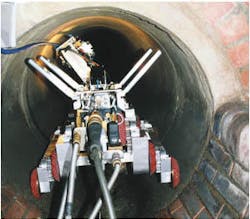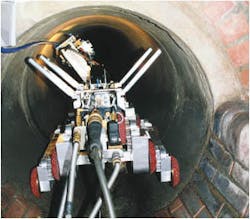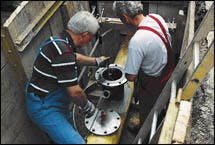Companies vie to win interest in cable-installing robots
Two robotics companies are trying to convince American cities that they can cheaply install cable in metropolitan areas without digging up city streets.
Ca-Botics Fiber Systems (www.ca-botics.com), based in Dublin Ohio, and the Paris-based Alcatel SA (www.alca tel.com) are holding demonstrations in several American cities, and in some cases using their robots to install cable in city sewer pipes.
The technology is not new, but is only now starting to see use in the U.S. after being used for nearly 15 years in Europe. The companies are trying to win interest by striving to build a better robot that lays down the most cables without damaging pipes.
"We see a bright future," says Klaus Nothofer, director of product management right-of-way solutions for Alcatel. "We see room to make it cheaper. This technology is on the market and it works."
But before the robot market here expands, the companies have to convince the likes of sewer authorities, engineers and municipal officials, who have until now been skeptical about a robot that attaches rings and other cable-holding clamps to the interiors of sewer pipes.
With the demand for increased bandwidth, telecom contractors are scrambling to get optical fiber as close to the user as possible. And in the metropolitan area, where optical fiber is needed most, the task has become increasingly difficult. Digging up roads and putting in cable is often impractical due to municipal regulations, high costs, and the potential to damage water and gas lines. The work also causes disruptions to traffic, neighborhoods, and existing networks.
"Some municipalities are overburdened with street-opening permits, and residents and taxpayers are fed up with delays," says Jack Conie, president of Ca-Botics Fiber Systems.
"When you dig up all the streets to install new fiber, it's difficult and expensive, and not liked by people," adds Nothofer.
But the robotics technology has the potential to make a huge difference. The robots were designed in the early 1990s to deploy optical fiber quickly and inexpensively throughout Europe and Japan. They were crafted to eliminate the need for digging around brick streets and Europe's historic districts.
The robots install optical fiber in a loop in a relatively small geographic area, bringing cable to businesses, office buildings, industrial sites and residential areas.
Ca-Botics wants to introduce its STAR (Sewer Telecommunications Access by Robot) system to North America and Canada. In mid-September, the company used the system to deploy optical fiber cables in Dublin, OH. Alcatel, meanwhile, has used its FAST (Fiber Access by Sewer Tubes) remote-controlled robot to install cabling in Albuquerque, NM. It has also held demonstrations in Omaha, NE and Atlanta, GA.
The Ca-Botics system identifies a route using city maps and finds appropriate pipes in which to place cable. The company cleans the pipes and then checks their quality by television camera, making sure they would be an adequate host for optical fiber cabling. Using manholes as access points, the robot then takes the cable and attaches it to the pipes.
The Ca-Botics system is designed to have a low profile, without obstructing the capacity of the pipe.
The STAR system can install up to two cables at a time, deploying 92 strands and occupying less than 1% of the pipe's cross-section.
Conie says the Ca-Botics system can install cable 8 to 10 times faster than traditional methods, and at a deployment cost that is about one-third of the traditional cost.
Alcatel's robot, designed in 1997, installs ring clamps in the pipe's interior every 1.5 meters. The clamps are especially designed to protect the sewer pipes from being damaged. The cables are then brought manually into the sewer and hung onto the clamps. The system costs between $70 and $110 per meter.
Both companies are trying to tout their product as the safer, cheaper method. Nothofer claims Alcatel's robot is easier on the sewer pipes than the Ca-Botics solution.
"We don't use that technology," says Nothofer. "It is damaging, and cannot be used with all sewer materials.
Ca-Botics counters, however, saying its product has yet to damage a pipe.
"We don't damage the pipe," counters Ca-Botics' Conie. "And our system is unique because you can maintain the sewer pipe after it (cable) has been installed. So, it allows a great deal of flexibility once the fiber has been deployed."
Conie notes that Dublin, OH installed a conduit bank to eliminate unnecessary excavating. The city needed more cabling as it continued to grow, adding a new high school and police substation, and it would have taken the city more than six months to dig up roads to put in new cabling. The Ca-Botics robot, however, did the job in a little more than two weeks.
-Brian Milligan


